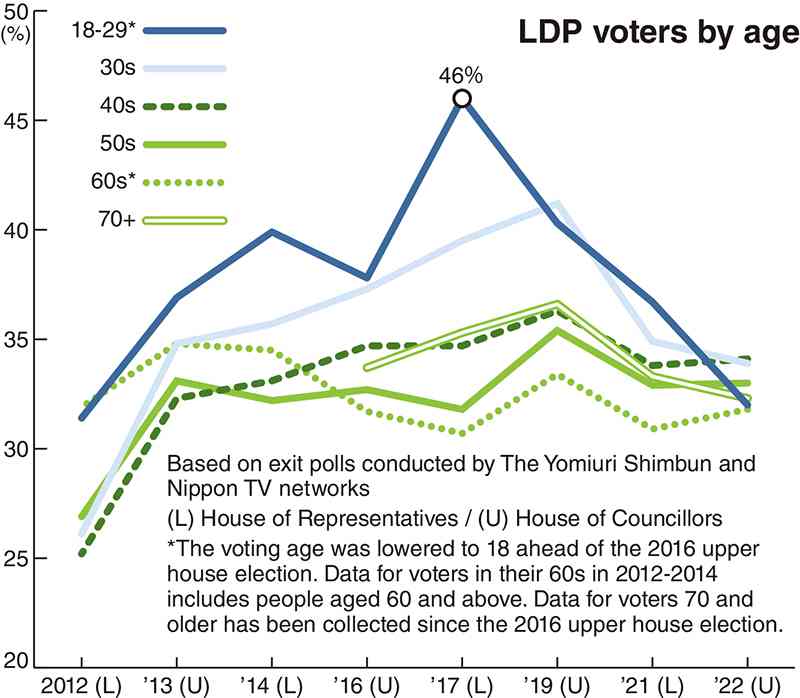Young voters shying away from LDP

Young people early voting in Fukui City in July.
16:15 JST, August 16, 2022
Young voters appear to be distancing themselves from the ruling party, according to data from exit polls jointly conducted by The Yomiuri Shimbun and Nippon TV networks in lower and upper house elections over the past 10 years.
Among people aged 18-29 who voted in this year’s House of Councillors election, 32% voted for the Liberal Democratic Party, compared to 46% in the 2017 House of Representatives poll.
Nippon Ishin no Kai (Japan Innovation Party), the Democratic Party for the People (DPFP) and Sanseito promoted policies that focused on young people in campaigns for the upper house election on July 10, and they are believed to have been the main beneficiaries in the shift away from the LDP among young voters.
In the 2012 lower house election when the LDP regained power, 31.9% of voters aged 60 or older picked the LDP, the highest percentage among all age groups.
Among people aged 18-29 who voted in the 2017 lower house election, during the administration of former Prime Minister Shinzo Abe, 46% voted for the LDP. Among voters in their 30s, 39.5% picked the LDP. Both figures were higher than those in other age brackets.
The LDP’s pledge to provide free preschool and higher education in its 2017 manifesto is thought to have triggered the surge in support among young people.
In this year’s upper house election, 32% of voters aged 18-29 and 33.9% of voters in their 30s picked the LDP, lower than the 34.1% of voters in their 40s who cast ballots for the ruling party.
Among people who said they usually vote for the LDP, 8.7% voted for Ishin and 4.9% for the DPFP — exceeding the 4.8% who voted for LDP’s coalition partner Komeito — while 3.1% voted for Sanseito and 3% picked the Constitutional Democratic Party of Japan, the largest opposition party.
Among voters in their 30s and younger in the 2019 and 2022 upper house elections, support for Ishin increased from 20.1% to 25.1%, and support for the DPFP went from 10.7% to 20.6%. In this year’s poll, 10.9% of voters in the same demographic picked Sanseito — which was founded in 2020 — surpassing those who picked the Japanese Communist Party at 9%.
“Policies proclaimed by Ishin, the DPFP and Sanseito have attracted support from young people,” Prof. Airo Hino of Waseda University’s Faculty of Political Science and Economics said.
Hino conducted an online survey on voter behavior on July 9, the day before the upper house election, with answers received from 4,811 people.
In the survey, more voters aged 18 to 39 than those in their 40s and older cited free higher education, the introduction of an elective surname system for married couples and the legalization of same-sex marriage as important election issues.
Ishin and the DPFP called for the expansion of free education and the introduction of an elective surname system for married couples in their manifestos.
Sanseito vowed to put more emphasis on the economy rather than pandemic measures and pledged to be more flexible about mask-wearing.
“There is a possibility that young voters were attracted to those parties because they are not satisfied with the ruling LDP, which focused on striking a balance in its policies,” Hino said.
“Conservative and centrist groups have appeared amid an expansion of opposition parties. Votes among young conservatives that had gone to the LDP have now become dispersed.”





